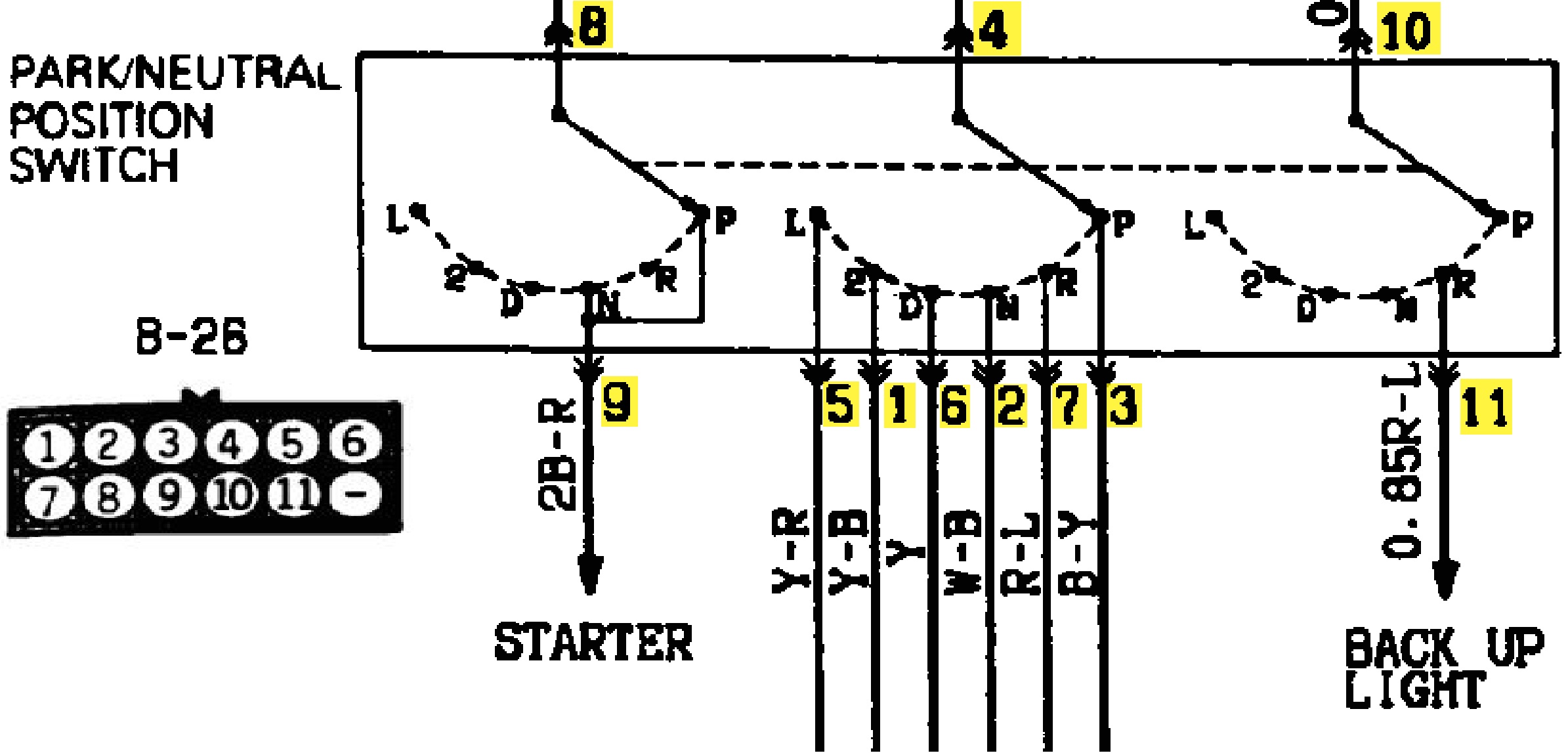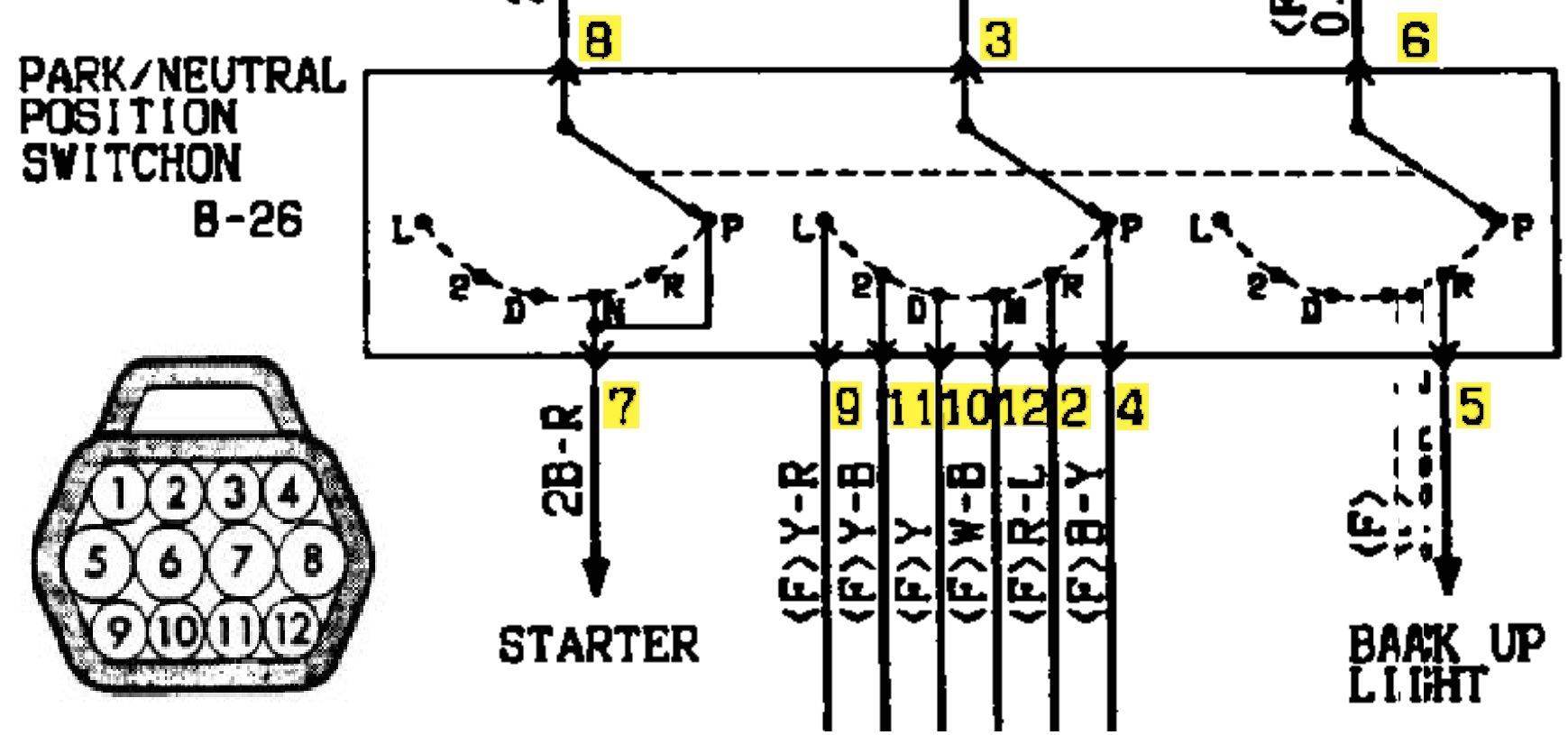Table of Contents
Auto Swap Wiring information
The harnesses in the car are different. They have the automatic wiring and plugs made into them and the manual cars are lacking all of this. The 2 harnesses that contain all of the automatic wiring is the interior harness, Dash harness, and the engine harness. This contains all of the wiring circuit that the automatic uses. The topics in this article will contain 2 explanations for each item. One of the options will be if you have all of the harnesses. The other option will be if you are lacking the wiring.
The engine harness contains all of the wiring that goes from the interior harness to the transmission plugs. The interior harness covers everything else. The cluster does have a extension like sub harness as well.
OBD Port Wiring
Main article: OBD Port
Transmission Wiring
One thing to note is grounding is important on this transmission. Without proper grounding static can build up where the converter goes into the transmission and the static discharges without proper grounding will eat away at the bushing.
Kickdown Servo Wiring
The kickdown server wiring is only used with a stock TCU. It tells the ECU when the transmission downshifts out of overdrive. The only reason this would be plugged in is if you are using a stock TCU. If you are manual shift or are using a an aftermarket TCU then its not used.
Pulse Generator Wiring
This is a four wire square plug and is confusingly the same plug as the shift solenoid plug. The pulse generator wiring collects from the top passenger side and the rear passenger side of each of the pulse generators with a clear sleeve. You really only need these with the stock TCU.
Shift Selector Wiring
There are two versions of this. Early style which is rectangle and was used for the first two years or so. The Late style was used from then on all the way through the 2G. This is the connector that you will run into most of the time. These connectors are actually available through Sheridan Engineering here.

| Early Style | |
|---|---|
| Pin | What it goes to |
| 1 | To pin 55 on TCU(2nd Gear) |
| 2 | To pin 53 on TCU(Neutral) |
| 3 | To pin 51 on TCU(Park) |
| 4 | 12v Positive From the Ignition switch |
| 5 | To pin 56 on TCU(1st Gear) |
| 6 | To pin 54 on TCU(3rd Gear) |
| 7 | To pin 52 on TCU(Reverse) |
| 8 | From Starter Relay |
| 9 | To Starter |
| 10 | 12v positive for Reverse Lights |
| 11 | To reverse lights |
| 12 | Blank |
| Late Style | |
|---|---|
| Pin | What it goes to |
| 1 | Blank |
| 2 | Reverse output to TCU(Pin 32) |
| 3 | 12v Positive From the Ignition switch |
| 4 | Park output to TCU(Pin 31) |
| 5 | Output to Reverse Lights |
| 6 | 12v positive for Reverse Lights |
| 7 | Ground for Starter Relay Control |
| 8 | 12v out from Starter Control Relay |
| 9 | 1st Gear output to TCU(Pin 36) |
| 10 | 3rd Gear output to TCU(Pin 34) |
| 11 | 2nd Gear output to TCU(Pin 35) |
| 12 | Neutral output to TCU(Pin 33) |
Solenoid Wiring
This is a four wire square plug and is confusingly the same plug as the pulse generators. The solenoid wiring comes out on the front of the case and has a black sleeve. The wire colors are the same on 1G and 2G except for one wire. These connectors are actually available through Sheridan Engineering here
| Pin | Wire Color | What it goes to |
|---|---|---|
| 1 | Blue | Pressure Control Reduction Solenoid Valve |
| 2 | Red | TCC Lockup Solenoid Valve(2G ONLY) |
| 3 | Orange | Shift Control Solenoid Valve A |
| 4 | Yellow | Shift Control Solenoid Valve B |
| Solenoid Operation | ||
|---|---|---|
| Gear | SCSV A | SCSV B |
| Fourth | Off | On |
| Third | Off | Off |
| Second | Off | On |
| First | On | On |
VSS / Speed Sensor Wiring
There are various ways of dealing with VSS sensors on autos. 1Gs are cable driven. Cable drive is required for the dash speedometer to work. There is a signal wire that goes from the cluster to the ECU and to the TCU to read speed. 2gs are fully electronic. The problem with 1g cable drives is sometimes the signal can be slightly dirty and there is somewhat of a delay or even some variance as the cable can twist tight. Chances are if you have a stand alone you will have issues with it reading the cable VSS signal. For that is a device that goes between the transmission and the cable and sends a signal. Its called the Terratrip Japanese Gearbox Probe or Brantz Tripmaster Japanese Gearbox Probe. Its a rally part and isnt sold in USA as of yet so its not easy to get. This is what you would need for stand alone to read the speed and you would just set it up like a 2g or Evo VSS and alter the calibration offset in the ECU until the speed reads correctly.
Alternatively the 3000GT speed sensors also work well. They are low profile, attach to the cable and have the same plug as a 2g VSS.
Factory Transmission Temperature Wiring
The factory transmission temperature probe is essentially just a switch like a non adjustable thermostat. It just turns on the A/T Temp light indicator on front dome light. Its not an actual temperature sensor and should not be used as such.
Engine Harness

AT Temp Overhead Light Wiring
This is the dummy light that comes on at a specific temp and lights the AT Temp indicator in the dome light. This is 1G only. If 2G has this in the cluster im not sure of.
TCU Wiring
Main article: TCU
Gauge Cluster Wiring
There is auto specific wiring for the guage cluster. It is only for the indicator lights for Eco/Power mode and Overdrive on and off. Its not pertinent for function to have these. You would need to have the interior harness as well as the cluster.
Pedal Wiring

Shifter Wiring
The shifter wiring is quite simple as there are only 2 things in this that need wiring. One is the overdrive on / off switch and the other is the light for under the top of the shifter where it says PRND2L. This bulb is a 1157 style with a flexible translucent green cap over it. The wires are green and green with red dot. The bulb wires go into the upper corners of the plug.
The overdrive on / off switch is 3 wires. One is yellow with a white stripe, one is black with a white stripe and one is yellow with a white stripe.
Main article: Shifter
Main article: Kiggly Blue Wire Mod for manual shift
Power / Economy Mode switch
This switch just essentially changes the shift points in the TCU. When in Eco mode it will shift early. If you put it in power mode it completes a circuit to the TCU and the TCU changes to a secondary shift map with higher/more aggressive shift points. This button is in no way connected to the ECU nor does it change anything with the engine at all. In case it needs to be said, no it does not raise the boost.


